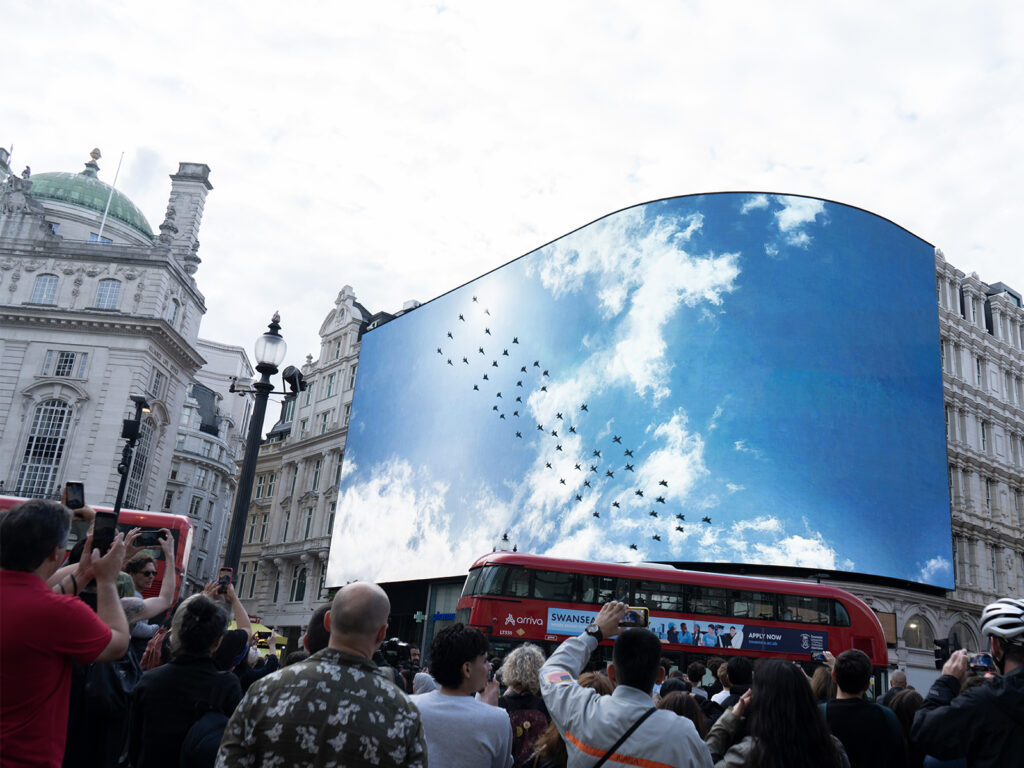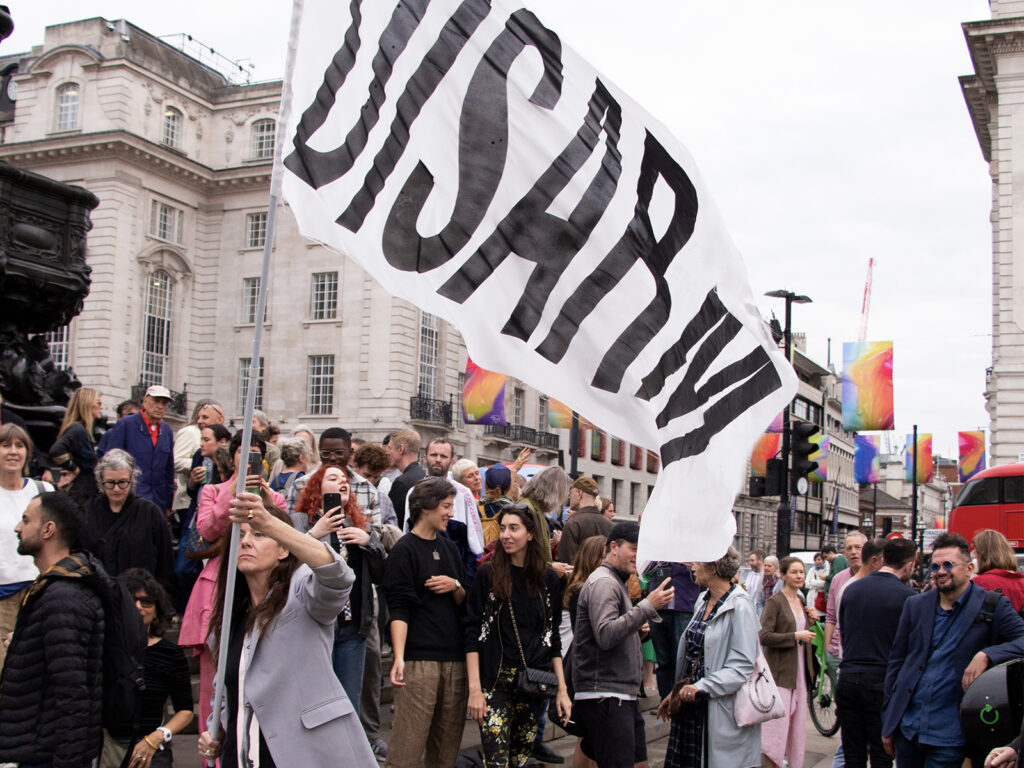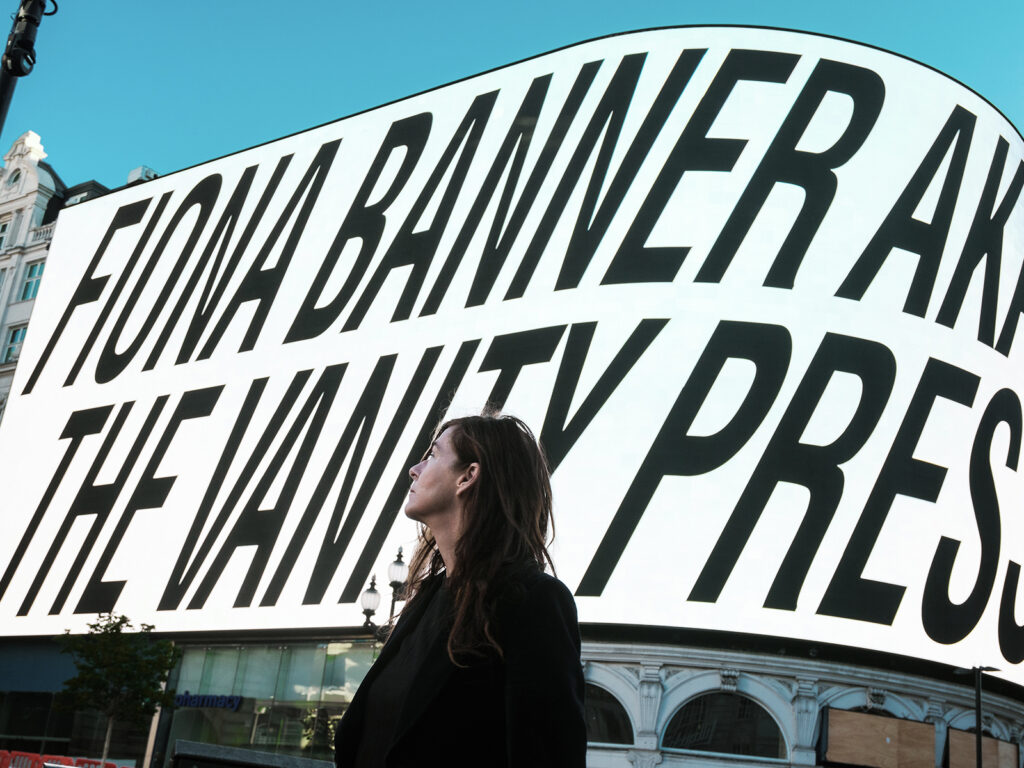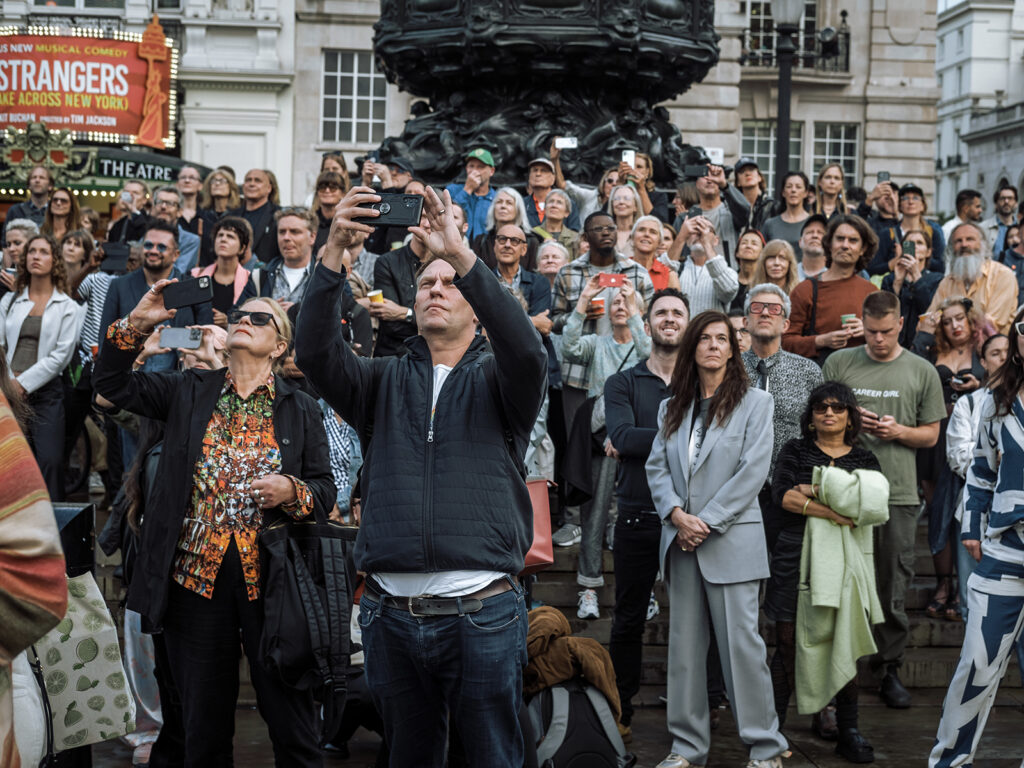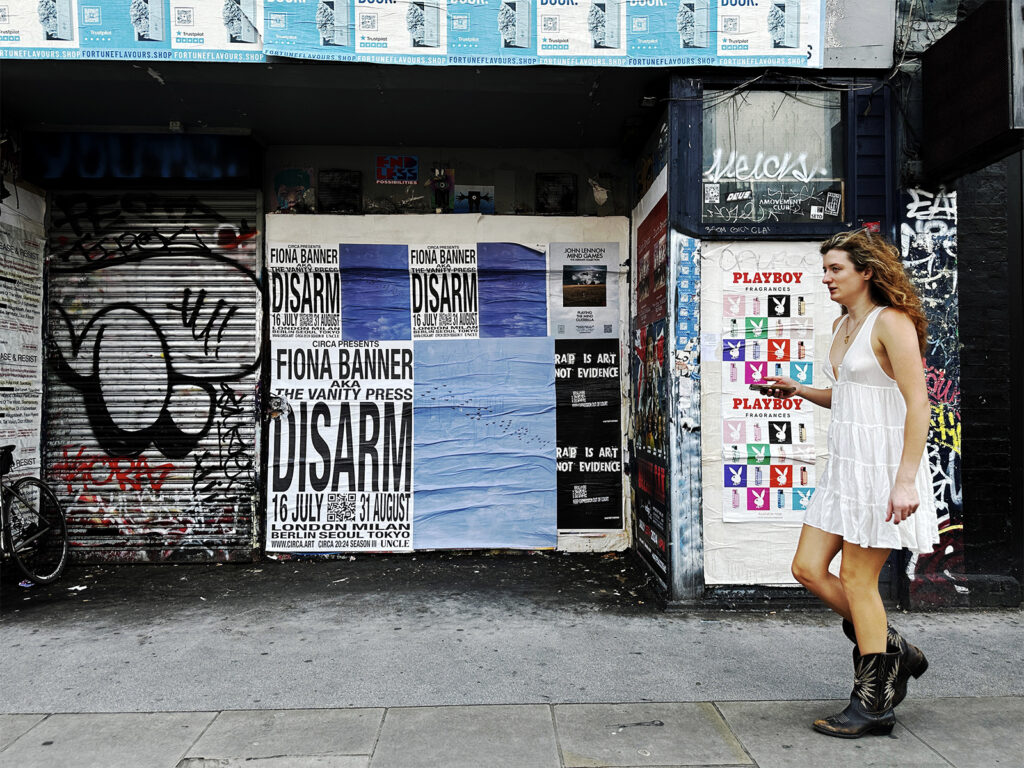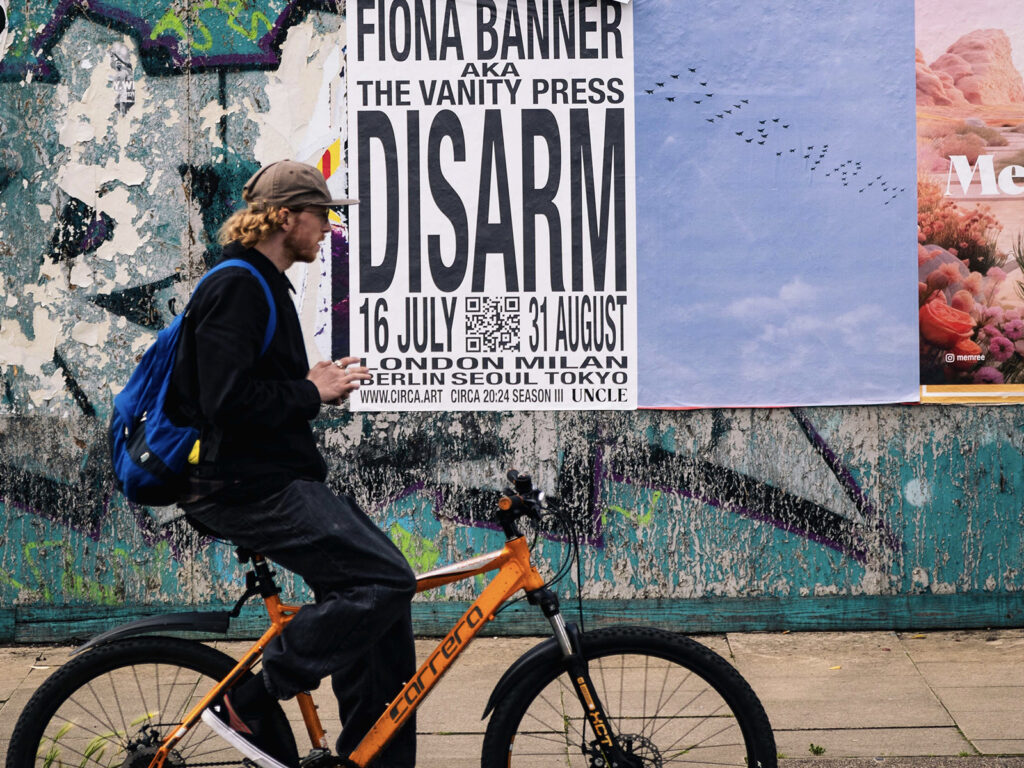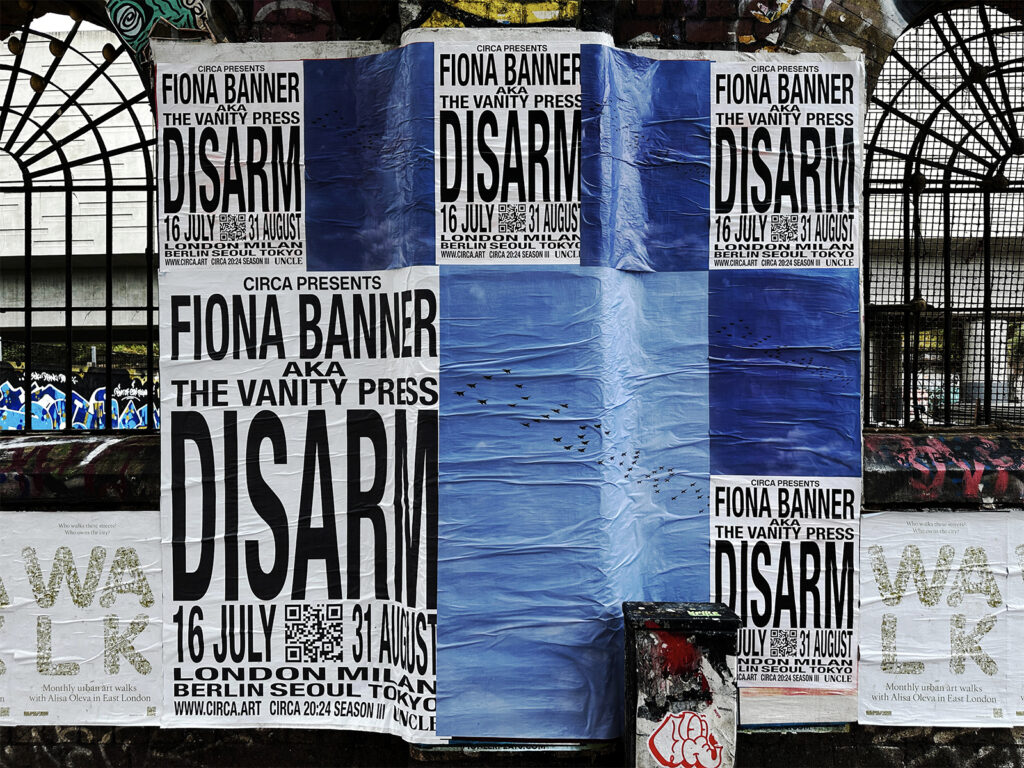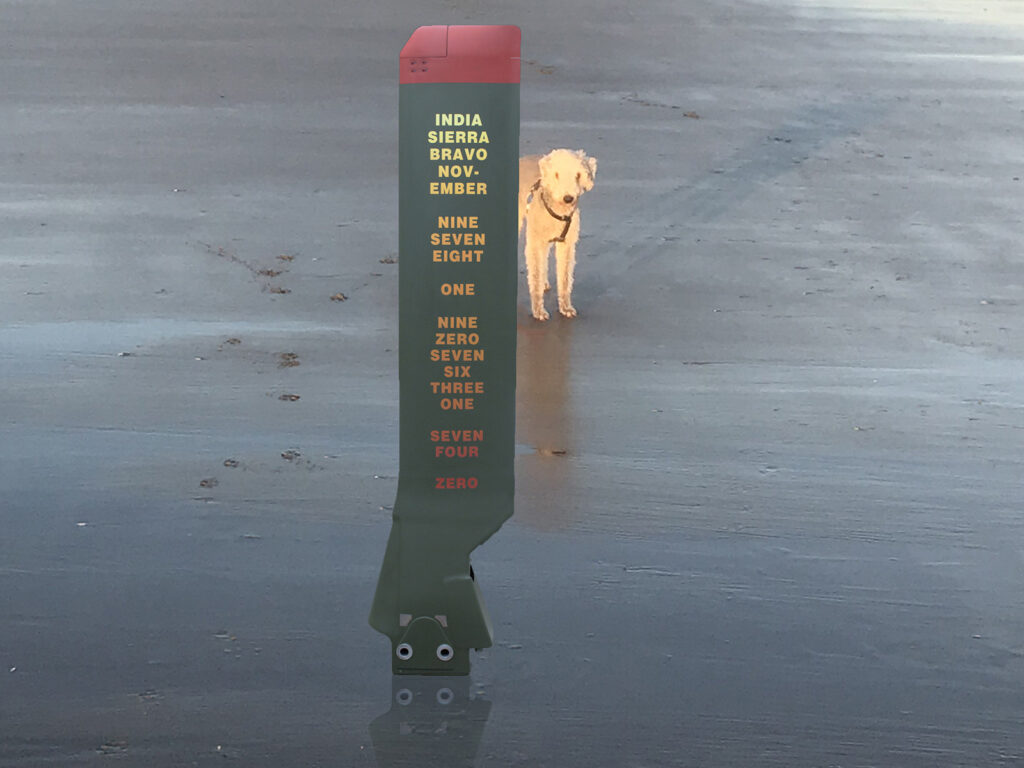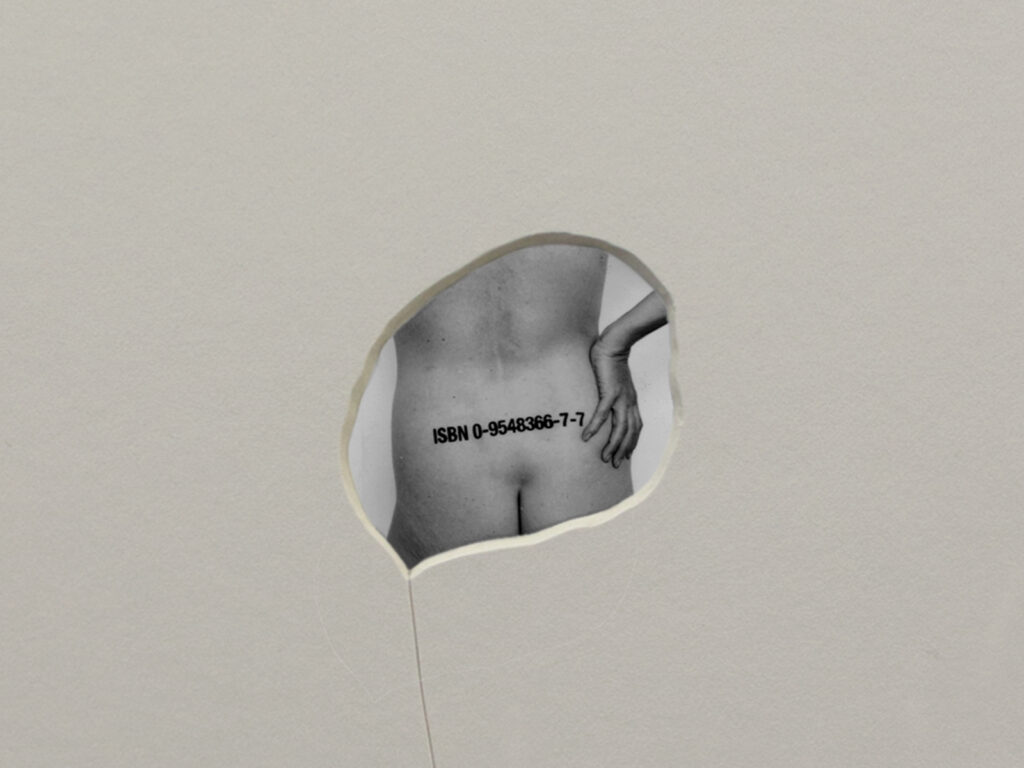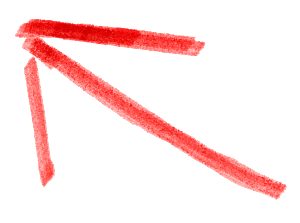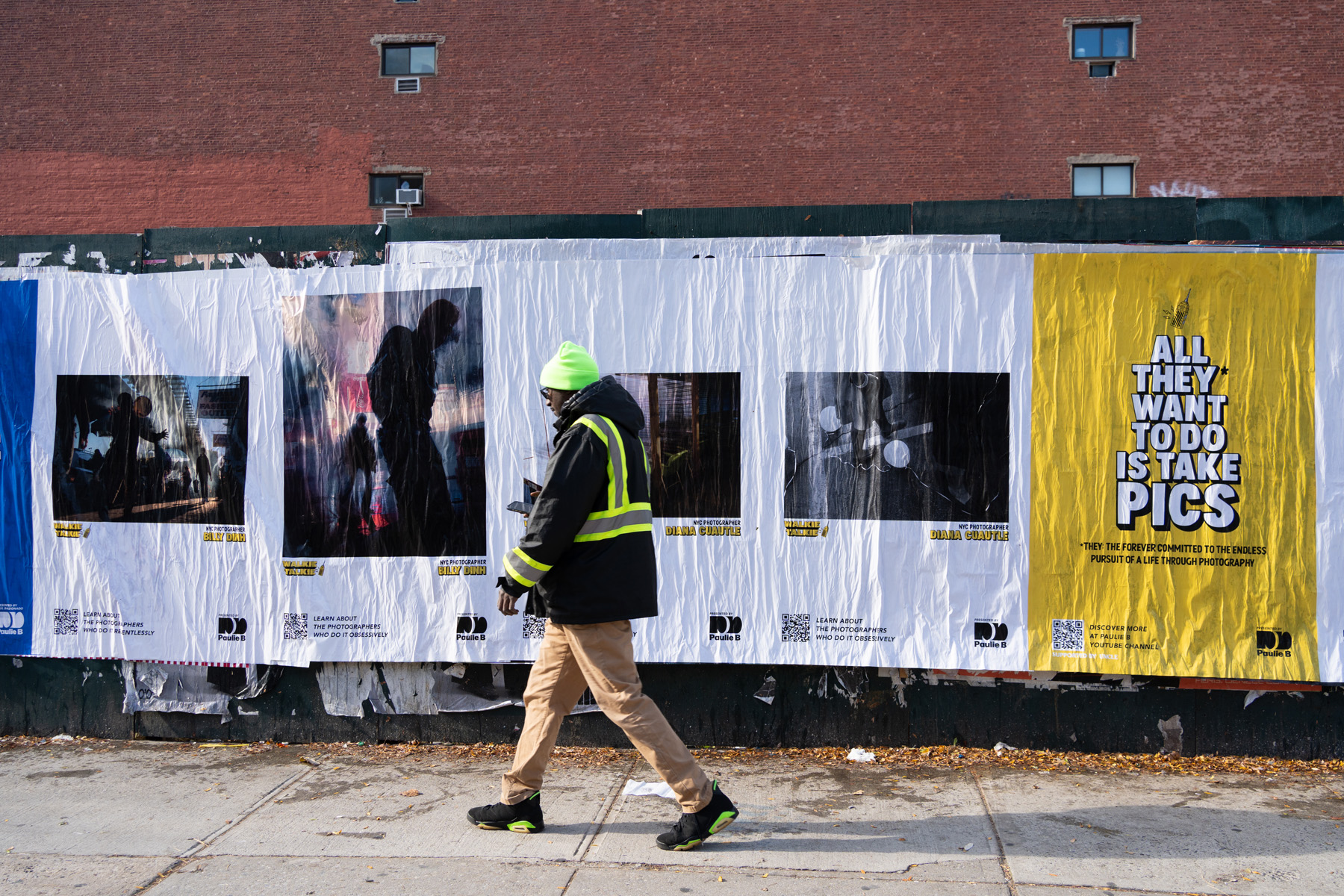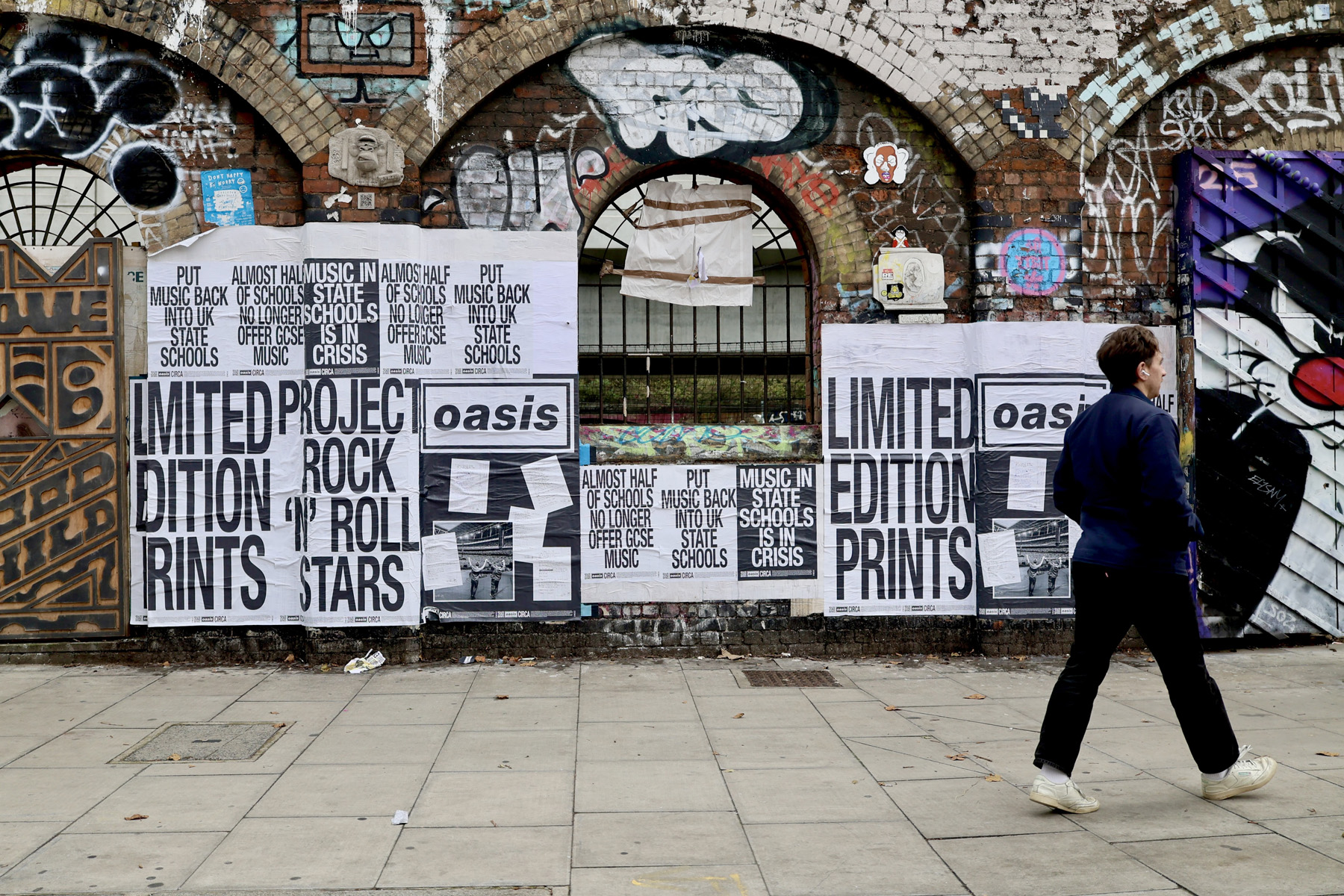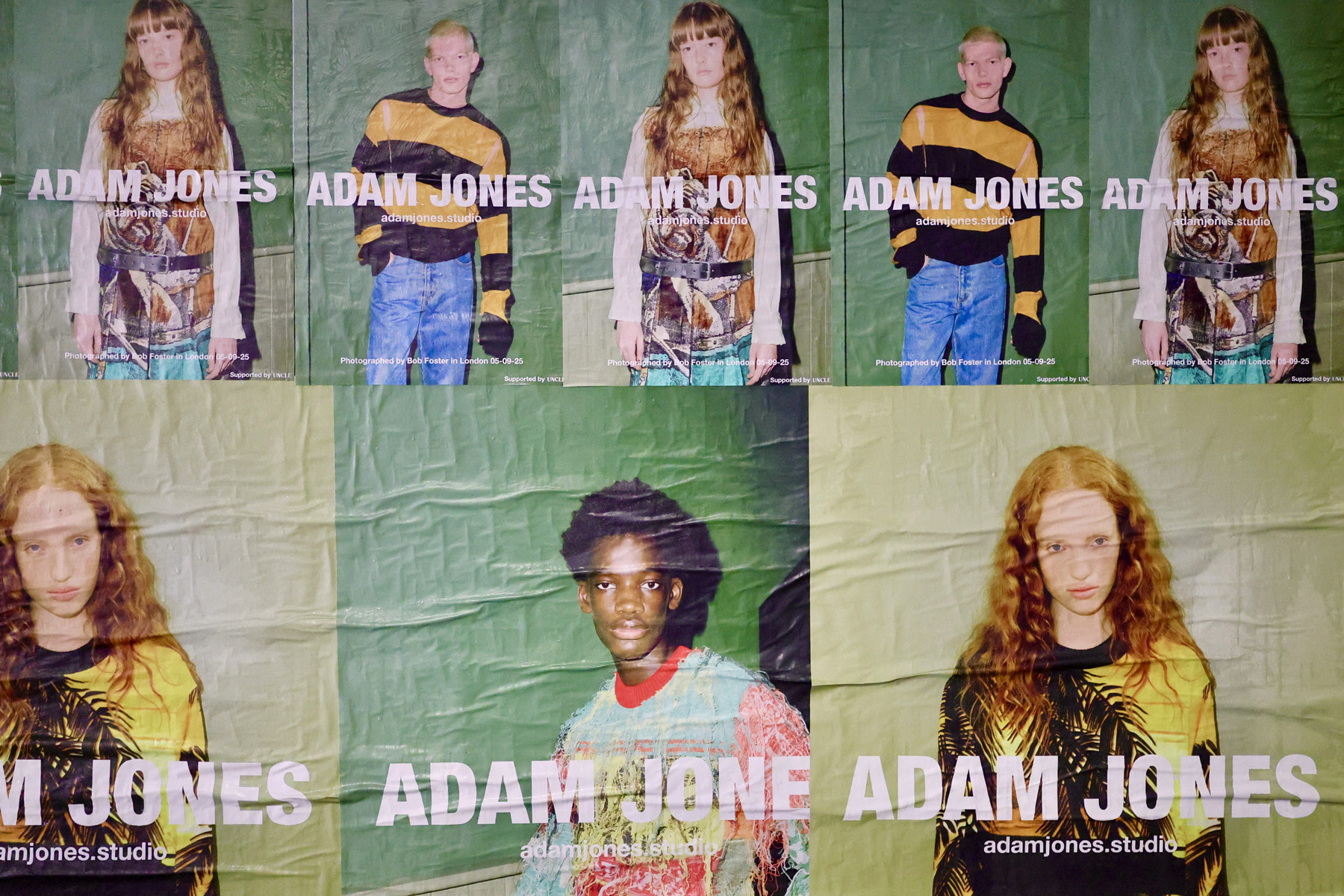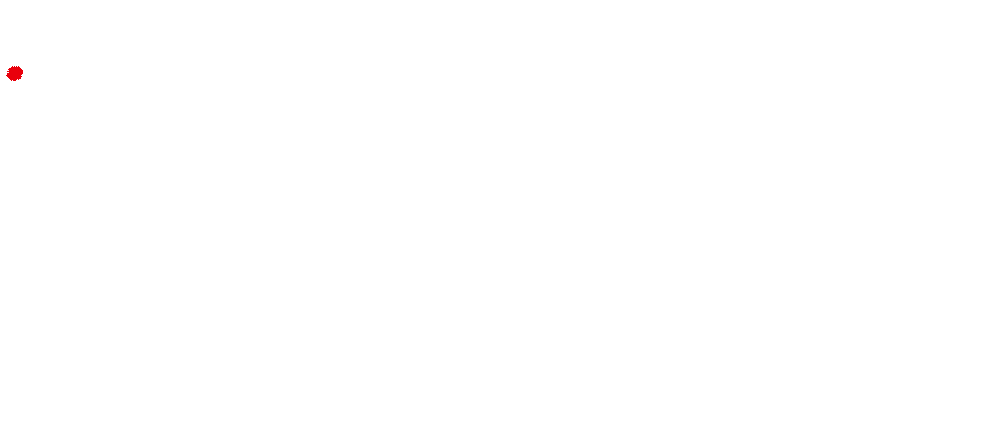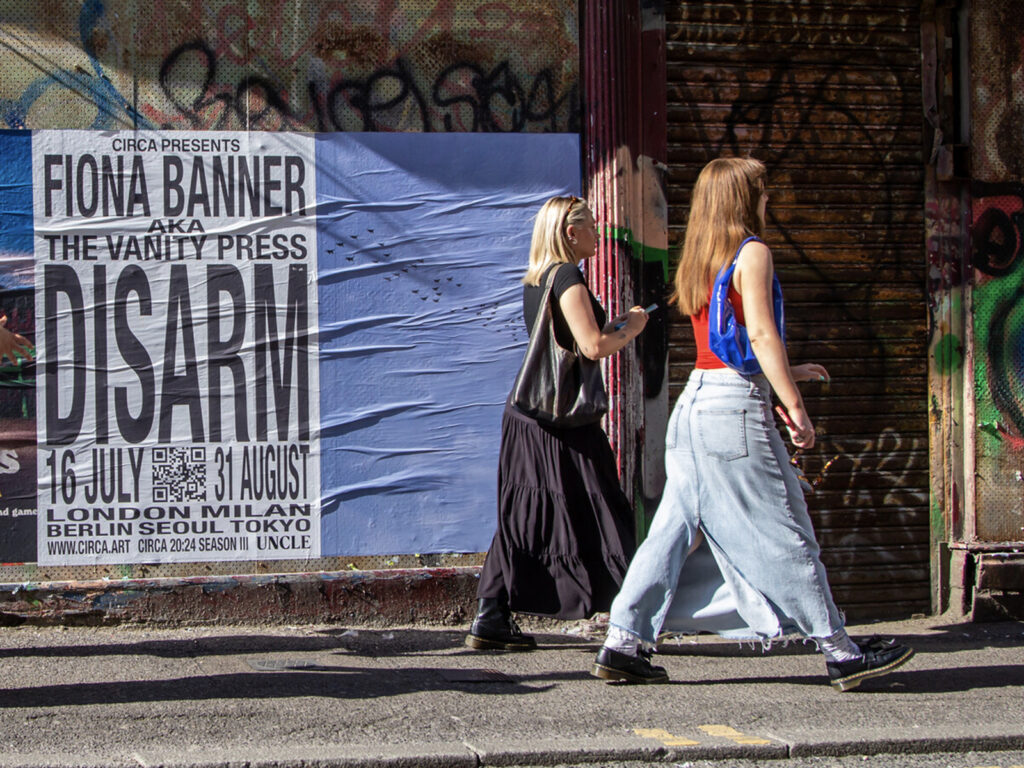
DISARM is a public artwork display from artist Fiona Banner commissioned by CIRCA in partnership with UNCLE. The creative itself has taken shape in multiple mediums since it’s creation, culminating in a showing on the digital screens of Piccadilly Circus. Known for their commercial content, these screens provide a powerful platform for a campaign focused on political and social commentary. It will be shown daily at 20:24pm (BST) on that screen, plus others globally until the 31st August. To amplify the campaign’s message, we also facilitated a national flyposting showing, drawing attention and support for its agenda.
The artwork presents a striking juxtaposition: military aircrafts, typically associated with destruction, spelling out the word ‘DISARM’. This visual statement challenges viewers to reconsider the implications of military power and the often-unexamined nationalism associated with such displays. Whilst the roar of the planes and their formations can be thrilling and beautiful, they also are underscored by the stark realities of nationalistic pride and the obscenity of war. The aim of the artwork being to provoke thought and conversation about peace and excess, especially via the interconnectedness of nations across the globe that we hope strive for unity.
UNCLE conducted an in-depth interview with Fiona Banner to explore the full scope of the artwork’s concept. The conversation reveals the creative process behind the piece, its personal significance to the artist, and the inspirations that led to its creation.
WHAT IS THE CONCEPT SURROUNDING THIS SERIES OF WORK?
DISARM is on the mega screen at Piccadilly Circus, London – Piccadilly Lights… A super public intersection…It’s a public artwork that happens daily for 2 months.
DISARM takes from the viscerally and direct impact of a military flypast, its self a very public kind of performance, and subverts the usual jingoistic message of military power, so the planes in formation spell out the word DISARM.
A few times a year a flypast goes right over my studio. It’s weirdly exciting, such a brief moment of extreme weather, of obscene ego and nationalist folly, yes, but it also hits you viscerally, something about the planes high in the sky performing like that, is emotional, frightening… possibly beautiful.
We always rush out to see it when we hear the roar… then afterwards talk about how fucked it is. Lately they have been spelling out C R, the kings initials, things like that – hubris writ large.
Piccadilly circus spot is a centre of establishment in many ways, and the screen is top capitalism, in normal times it’s a constantly replicating quilt of unrequitable consumerist desire. The flypast is an interruption, or take over of that, it plays into that excessive and perverse energy – the word ‘disarm’ also refers to that excess, and our combative relationship with nature, as well the military.
The poster campaign goes long side that. Fly-posters for a fly-past…street posters are always animated because they are experienced in passing.
WHY IS THE WORD ‘DISARM’ FEATURED SO PROMINENTLY?
In spelling out the word DISARM, letter by letter, the airplanes are calling for their own demise, or emasculation at least. It’s is a moment where language meets its limits.
The work is grandiose as is a flypast, and not, disarm is a big word, and also a physical word, it also refers back to the domestic sphere of our own bodies, dis arm.
I was thinking that there is a naivety to making the statement ‘disarm!’, which is to say the word has become detached from its reality – how do you use that word in a way so that it redresses the cliché, or otherwise put so that the word speaks with impact, speaks its own complexity.
Addressing the biggest global Conference on Disarmament this year U.N. Secretary General Antonio Guterres said “Something is very wrong if a disarmament conference leads to no meaningful disarmament, year after year.” The word has become taboo, and all we are taking about at the moment is ramping up arms. The arms industry is all about control, but it is out of control… It has become normalised.
There is very little proper public conversation around peace at the moment. Seems like a time to say Disarm!
HOW HAS THIS SERIES OF WORK DEVELOPED OVER TIME?
It started as a series of story boards or drawings, and then slowly got realised. It became clear to me the planes had to be from different, non-allied countries. D – Flying Leopard, I – Typhoon, S – Flanker, A – Falcon, R – Golden Eagle, M – Lightning, so there is contention in the medium of the language.
The action happens amongst the birds, the sky…the boredom of an undistinguished bucolic land scape… the sound coming first and waiting for the planes to erupt into the frame.
Like any flypast its uber boring and uber exciting…. Waiting and the excessive action, then waiting…. Plus there is the perversity that the planes are named after forces of nature… so we are looking at nature? I realised the suppleness of nature was an important antidote to the harsh roaring anti nature of the planes… the space between the letters that makes the word possible.
Years ago I made a series of works called Chinook. One involved a chinook performing a sky ballet at an air show. Perhaps I have been slowly making this work for a long time without realising it.
WHY ARE YOU OFTEN DRAWN TO THEMES OF MILITARY?
I grew up in one arms race, and then there was another around the time I started working properly as an artist. Cold wars were the wallpaper to growing up in the 70s and later 80s – our primitive dark side spelt out in high technology.
TELL US ABOUT THE COLLABORATION WITH CIRCA ART?
I got to know Josef O’Conner when he was thinking about starting Circa and he asked me to make something for Piccadilly Lights then. As time went on we agreed that it should be something active, a happening, something that implied, or called for, change. I had recently put massive full stop sculptures into the sea, with Greenpeace, part of an action against destructive fishing…and delivered another to the front door on DEFRA. Disarm is another bit of language in action, it plays into the public nature of Piccadilly Lights. Whilst I have been working on this different conflicts have flared up and the global context has changed. It has been hard to find a time when the work does not feel like a response to a specific context.
DID GROWING UP IN LIVERPOOL SHAPE YOUR CREATIVITY?
It’s hard to know these things. There is often an underside of humour, as a way of saying things in my work – something physical and connected with language… perhaps there is an element of bravado…
TELL US ABOUT SOME OF THE MOST PROMINENT MOMENTS IN YOUR CAREER? BEING FEATURED IN THE MUSEUM OF MODERN ART OF BEING SHORTLISTED FOR THE TURNER PRIZE ETC…
Most prominent moments have been human… back room interactions… the making stuff… the linear cv, or career moments aren’t actually the big moments, I try to not make them my markers.
WHAT IMPACT DOES THE CITY OF LONDON HAVE ON YOUR WORK?
Sometimes it’s restrictive, sometimes it’s a release. The friction is important.
WHAT ARE SOME HIDDEN GEMS IN LONDON YOU LOVE?
The gaps and in-between bits, the community gardens…. lets protect them!
FAVOURITE THING ABOUT LIVING IN LONDON?
The mix of human voices and accents.
DOES CULTURE PLAY A KEY PART IN YOUR CREATIVITY?
Always by osmosis mainly. I am grateful to live now, but now is also shit in many ways…
WHAT DO YOU HOPE PEOPLE TAKE AWAY FROM THIS CAMPAIGN?
It may sometimes seem small or stupid, naive, but if you believe it find a way to say it.
Stand for change.
